Boasting an attendance of more than six million people every year, Munich’s Oktoberfest is officially the world’s biggest party.
While several other cities across the world also hold Oktoberfest celebrations, modeled after the Munich event and held on similar dates, none rival the authenticity and grand scale of the original.
Unfortunately, the closest I have ever come to Oktoberfest is drinking Oktoberfestbier and polka dancing at the Oktoberfest festivals in Columbus, OH. Needless to say, that just doesn’t cut it.
Alas, I will be forced to celebrate Oktoberfest state-side until circumstances finally allow me to travel to Germany for the real festival. (This year I will be celebrating Oktoberfest in Orlando, Florida!)
Surprisingly, I know very little about Oktoberfest except that it is a massive festival that spans across 16 (sometimes 17) days - consisting of excessive beer & German food consumption and lots of debauchery.
Considering that the 175th Oktoberfest is only a mere 12 days and the shelves have already been stocked with various Oktoberfest biers, I decided that now is a perfect time to research the world’s largest party.
According to history, Oktoberfest is the result of an extended wedding reception that followed the marriage of Crown Prince Ludwig of Balvaria and Princess Therese of Saxony-Hildburghausen on October 12, 1810. Both were later to become King & Queen of Bavaria.
The citizens of Munich were invited to attend the post-wedding festivities, which lasted several days and concluded with a great horse race. The decision to repeat the horse races in the subsequent year gave rise to the tradition of the Oktoberfest.
The first Agricultural Show, designed to boost Bavarian agriculture, was included in with the horse racing festivities in 1811. In the year 1812, Oktoberfest was canceled as a result of Bavaria’s was involvement in the Napoleonic war.
Carnival booths were introduced in 1816, with prizes mostly consisting of silver, porcelain and jewelry. And in 1918, the first carousel and two swings were included into the event.
The founding citizens of Munich assumed responsibility over festival management in 1819 and it was agreed that the Oktoberfest festival would be celebrated each and every year without exception.
INTERESTING FACT: Since its beginnings the Oktoberfest has been canceled 24 times due to war, disease and other emergencies.
The first Oktoberfest parade, honoring the marriage of King Ludwig I and Therese of Bavaria, took place in 1835. Since 1850, the parade has become a yearly event and an important component of Oktoberfest. Each year some 8,000 people, mostly from Bavaria & dressed in traditional costumes walk through the center of Munich to the Oktoberfest.
The year 1850 also marks the first appearance of the Statue of Bavaria, commissioned by Ludwig I of Bavaria and constructed by Johann Baptist Stiglmaier and Ferdinand von Miller. The Bavaria statue is a bronze-cast statue of a female figure representing Bavaria’s “secular patron saint.” She is located at the border of the Theresienwiese in Munich, Bavaria, Germany - where Oktoberfest takes place each year.
Thirst was originally quenched at beer stands, which eventually turned into beer tents in 1896. The beer tents and halls were originally set up by enterprising landlords with backing from local breweries and have been a main staple of the event ever since.
Since 1950, there has been a traditional festival opening consisting of a twelve gun salute and the tapping of the first keg of Oktoberfest beer at noon by the Lord Mayor of Munich with the cry “O’zapft is!” (which literally translates to “It’s tapped!” in the Austro-Bavarian dialect). This event is held the first Saturday of each Oktoberfest in one of the enormous beer tents. Once the barrel is tapped, all visitors are then allowed to quench their thirst and the massive party officially begins!
The year 1960 marked the end of the horse races. By that time, Oktoberfest had already turned into an enormous world-famous festival and has since grown to become the largest folk fest in the world.
This year, Oktoberfest officially commences on September 20th at 12 o’clock noon and ends on the evening of October 5th. Over 6.2 millions visitors are expected to participate in the festivities and consume over 6,940,600 liters of Oktoberfestbier.
Oktoberfestbiers have been served at Oktoberfest since 1818 and are supplied by 6 breweries known as the “Big Six.” These include Spaten, Lowenbrau, Augustiner, Hofbrau, Paulaner and Hacker-Pschorr.
Originally, Oktoberfestbiers were traditional German pale lagers called Märzen. They were brewed in March and allowed to ferment slowly during the summer months. They typically run at about 5 to 6% abv. Technically, authentic Oktoberfestbier is brewed only by the breweries within the city limits of Munich. Today, the terms Oktoberfest and Märzen are used by non-Oktoberfest brewers in Germany and the USA to market pale lagers of this strength.
THE GERMAN BEER INSTITUTE has an excellent article about this history Oktoberfestbier HERE.
I will be honest. Lagers do not particularly excite me. In fact, I tend to avoid that style of beer as much as possible. HOWEVER, I am predisposed to having a preference to Spaten - over all the other Oktoberfestbeirs.
Is it possible to have such a predisposition? YES. My father is a marketers dream. He is the king of brand preference and brand loyalty. When he finds something he likes, he becomes an obssesed man. And this is how he is with Spaten.
It did not matter where he goes and how much beer is already being provided, my father ALWAYS brings his own beer - and it is ALWAYS Spaten. At any given time, the refrigerator in his garage is loaded with Spaten.
For my 21st birthday my dad picked out the keg. And guess what he chose? Yep, that’s right … SPATEN!
Needless to say, I do not love the stuff. It is decent for a lager BUT - once again - lagers are probably my least favorite style of beer.
Either way, in the spirit of the season and Oktoberfest, I vow to taste and review [as objectively as possible] a few authentic as well as a few “non” authentic Oktoberfestbiers! All in the name of research, of course …
And as always, I welcome all suggestions!!!
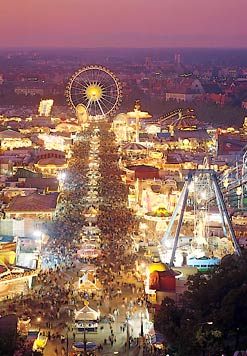
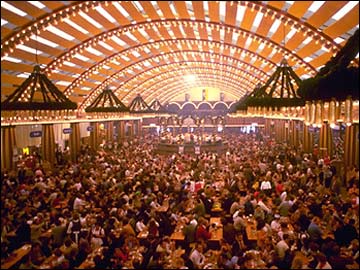


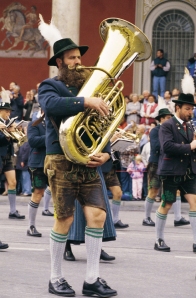



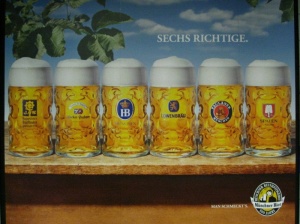
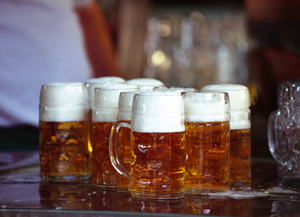
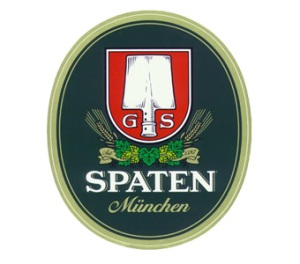


Leinie’s made a terrific Oktoberfest in 2004, and this year they have almost lived up to that one. Almost.
Wow, another well researched post. I take it you missed Oktoberfest in Columbus over the weekend.
Great overview - I’m learning stuff over here!
The best part is that “Mad” King Ludwig had something to do with it! Man, that guys was a trip…
As for lagers - Like you, I tend to avoid the bottom-fermenting beers unless they are really something special (Victory’s is pretty quaffable).
My dad and I spent a little over a week in Munich for Oktoberfest 2006 for my 30th birthday. Absolute time of our lives. And though going to the Wiesn and hanging out at all the great beer tents was a blast (Paulaner and Hofbrau were our top two - almost always getting the dunkels), some of our best memories were when we got a little burnt out on that and would head over to some of the great beer gardens (Augustiner Keller was our go-to) or to some of the bars to hear some great stories from the locals. It was amazing how friendly everyone was over there.
Our routine was crazy in hindsight. Sleep in every morning and skip breakfast. Head over to the Wiesn and grab lunch and 3 liters. Come back to hotel and take 3 hour nap. Go back out that night for dinner and 4 more liters followed by our favorite dessert in the world - the radler (a liter of half beer half lemonade). Come back to hotel and sleep it off, save for having to pee every 30 minutes during the night.
Our main lesson after day one though - WATER IS CRUCIAL. After our first day we had the skull splitters going on and quickly found the formula: one liter of water for every liter of beer. Smart people would have had a liter of beer and a liter of water at the same time or back to back. Not us! We’d do our 3 liters then come back and drink 3 liters of water. It still worked, it was just a roundabout method. Either way it was the trip of our lives and we’d love to go back. I now say there are two things everyone should do at least once in their lives: Mardi Gras in New Orleans and Oktoberfest in Germany. Once is probably enough for most people but I guess I’m a glutton for punishment.
Great post-
I’m not sure if Brooklyn’s Oktoberfest is available in C-bus (I used to partake in PA), but it is by far one of my favorite beers, a perfect mixture of malt and hops, robust but not too heavy, a great all around beer. It single-handedly open my eyes up to lagers, which I now love.
Great post! Generally speaking, I’m also not a huge fan of Lagers - in spite of that, I do enjoy the Spaten Octoberfest and think its a very tasty treat!
[...] I was doing my research and I came across an excellent post about the History of Oktoberfest by “The Beer Wench”. Her post on the History of Oktoberfest is among the best [...]
[...] Wench Sadly, tomorrow marks the last official day of the world’s largest folk festival - Oktoberfest. And unfortunately, yet another Oktoberfest has come and gone without me. I [...]